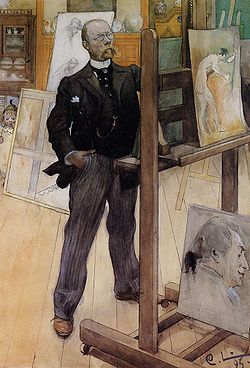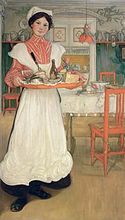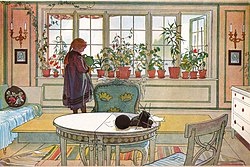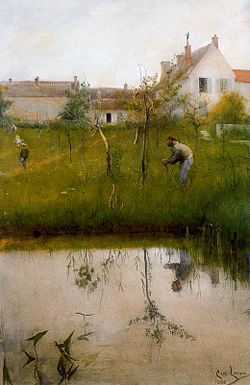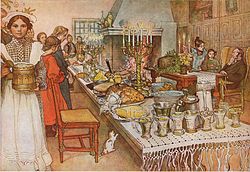Carl Larsson
Der er ingen kildehenvisninger i denne artikel, hvilket er et problem. (november 2024) |
| Carl Larsson | |
|---|---|
 Selvportræt, 1891 | |
| Personlig information | |
| Født | 28. maj 1853 Storkyrkoförsamlingen, Sverige |
| Død | 22. januar 1919 (65 år) Sundborns församling, Sverige |
| Dødsårsag | Hjerneblødning |
| Gravsted | Sundborn Kirke |
| Nationalitet | |
| Far | Olof Larsson |
| Mor | Johanna Carolina Erika Larsson |
| Ægtefælle | Karin Larsson (1883-1919) |
| Børn | Brita Larsson, Suzanne Larsson, Ulf Larsson, Pontus Larsson, Lisbeth Larsson, Mats Larsson, Esbjörn Larsson, Kersti Larsson |
| Uddannelse og virke | |
| Uddannelsessted | Kungliga Akademien för de fria konsterna |
| Elev af | Johan Gustaf Köhler |
| Medlem af | Grezkolonien |
| Beskæftigelse | Kunstmaler, gravør, bygningstegner, tegner, akvarelmaler, grafiker, forfatter, illustrator |
| Fagområde | Malerkunst, ungdomslitteratur, interiør design |
| Arbejdssted | Stockholm, Grez-sur-Loing, Falu Kommune, Paris |
| Kendte værker | Brita ved flygelet, Gustav Vasas intåg i Stockholm 1523, Portræt af August Strindberg, Ett hem, Svenska kvinnan genom seklen med flere |
| Genre | Portrætmaleri, landskabsmaleri, genremaleri, Akt, figurmaleri |
| Bevægelse | Arts & Crafts |
| Påvirket af | Japanese Prints, Impressionisme, Jules Bastien-Lepage |
| Nomineringer og priser | |
| Udmærkelser | Ridder af Æreslegionen (1901), Exposition Universelle |
| Signatur | |
 | |
| Information med symbolet | |

Prästgatan 78 i Gamla stan


Carl Larsson (født 28. maj 1853 i Stockholm, død 22. januar 1919 i Falun) var en svensk kunstner.
Carl Larsson er mest kendt for sine meget præcise skildringer af svensk landlig idyl.
Gaden ved siden af Hôtel Chevillon i Grez-sur-Loing (en), Frankrig er opkaldt efter Carl Larsson.
|
|
|
Referencer
- ^ Karin Spjälkjol findes på Wikisource.org (svensk)
Eksterne henvisninger
- Carl Larsson på Kunstindeks Danmark/Weilbachs Kunstnerleksikon
- Carl Larsson hos Runeberg.org af Axel Holck
| Spire |
Medier brugt på denne side
Artist stub
Carl and Karin Larsson combined new design with old traditions. Practicality dictated their interior design, but it was equally important that furniture and objects form an attractive harmony. This ideal was also propagated by others, including Ellen Key, who advocated homes that were in a new and light style, in her essay “Skönhet för alla” (Beauty for All) in 1899.
The Larssons moved to Lilla Hyttnäs, a house in Sundborn, in the summer of 1889. Here, Carl and Karin together created the interiors that made their home famous. Karin designed the furniture and textiles, which she embroidered and wove. A studio was fitted up in one of the hallways. It features many eye-catching details, including the funny man crowning a column. When a larger studio extension was added, this room became a workshop for the whole family.
The interiors of the Larsson home were characterised by rural simplicity. Nevertheless, every detail was carefully designed, with influences from England, Scotland and Japan. The kitchen, which was first and foremost a place for household chores, did not display the same modern interior style and comfort as the rest of the house.Self portrait, Carl Larsson
Illustration av Carl Larsson ur Sagor och Berättelser av H. K. Andersen 1875-1876
Signature of Swedish artist Carl Larsson.
Carl Larsson-gården with main entrance of Lilla Hyttnäs, home of Carl Larsson
Selfportrait of painter Carl Larsson
Forfatter/Opretter: unknown, Licens:
Illustration by en:Carl Larsson of the book "Folksagor" by Asbjörnsen and Moe, Stockholm 1927
The painting shows a naked man with his head held high standing on a gilded sleigh drawn by four strong men, two pulling and two pushing. A one-eyed priest is shown in the centre of the picture with the hammer of the pagan God Thor raised above his head. In front of the priest, with his back to us, is the executioner wearing a red cloak. His head is bowed. The knife he is holding is hidden from the victim on the sleigh but we realize that, at any moment, he will drive it into the exposed chest of the naked man. The venue that Carl Larsson has created for the sacrifice is the pagan temple in Gamla Uppsala. The royal victim is the mystical King Domald and the story is taken from the famous Old Norse Prose Edda written in Iceland by Snorre Sturlasson early in the 13th century. Snorre claims that Domald was sacrificed in order to appease the gods and to bring to an end several years of failed harvests. There is no other evidence that Domald ever existed.
When Carl Larsson had completed his painting showing Gustav Vasa's entry into Stockholm there was just one wall panel left empty at the museum. It is not surprising that Carl Larsson also wanted to fill it. And without the museum commissioning a painting or organizing a competition, Carl Larsson submitted a design of his own in 1911. As a contrast to midsummer which was portrayed in the Gustav Vasa panel he chose as his subject a Midwinter Sacrifice from Viking times. And as a complement to the royal triumph of Gustav Vasa he proposed a picture of a king being sacrificed for the good of his people.
The sketch gave rise to vociferous criticism when it was exhibited at the Nationalmuseum in 1911. Experts accused Carl Larsson of mixing together items from different periods of history. His vision was historically incorrect. Added to which, historical painting, such as the proposed Midwinter Sacrifice, had become less fashionable.
As opposition to his proposed painting grew, so did Carl Larsson's determination to carry out the project. As the most celebrated painter in Sweden he invested all his artistic prestige and he completed the vast painting at his own expense. The 80m2 canvas was temporarily hung in the museum in 1915. But after much debate all the way up to cabinet level, the painting was refused. It was taken down and, following the death of Carl Larsson in 1919, was shown at the Museum of Sketches in Lund for almost 40 years.
In 1983 the Midwinter Sacrifice was shown in Stockholm for the first time since 1915. It was borrowed for an exhibition on myths at the Museum of National Antiquities. Following this exhibition the painting was sold by the heirs of Carl Larsson to a Swedish art dealer. The Nationalmuseum refused an opportunity of buying the painting. The Museum of National Antiquities was interested in acquiring it but could not afford the price. A national collection to purchase the Midwinter Sacrifice was discussed but came to nothing. At the same time there was lively discussion in the press as to whether the painting ought to hang in the Nationalmuseum or not. Some people claimed that it did not have the artistic quality that one could demand of a work hung in the Nationalmuseum. Nor was the Old Norse subject matter relevant to the Nationalmuseum in that the historical collections had been removed in the 1930s to form the Museum of National Antiquities. In 1987 the Midwinter Sacrifice was sold at auction in London. It was acquired by a Japanese collector who greatly admired the painting. It was generally assumed that Sweden had now lost the painting.
But when the Nationalmuseum celebrated its bicentenary in 1992 with a major Carl Larsson exhibition, the Midwinter Sacrifice was borrowed from its Japanese owner. It was displayed in the entrance hall for the first time since 1915. Three-hundred thousand visitors saw the exhibition and a majority of them were positive towards the Midwinter Sacrifice. In 1997, after lengthy negotiations and thanks to generous financial help from private donors and foundations the Nationalmuseum was able to purchase Carl Larsson's Midwinter Sacrifice.This painting is undated, but it was probably made in Paris in 1880–82. The female model bears a resemblance to Gabrielle, the Frenchwoman with whom Carl Larsson lived in the years around 1880. This is almost the only work by Carl Larsson depicting contemporary Parisian life. Perhaps he had stolen a glance at his friend Hugo Birger’s paintings, which often featured women in fashionable outfits with or without an attending beau.
The engraving shows three boys playing by a river. The boy to the left is playing with a model ship. The boy in the middle holds a sword. The boy to the right, who seems to be the youngest, is digging with a spade and is next to a model horse.
In the bottom left corner there is the signature of Carl Larsson (1853-1919), the artist. In the bottom right corner there is the signature of Justus Peterson (1860-1889), the xylographer.
The image list on page 468 in the book describes this image as "Magnes (Mannus) tre söner", i.e. the three sons of Magne (Magni) or Mannus.Forfatter/Opretter: Holger.Ellgaard, Licens: CC BY-SA 3.0
Trapphall i Nationalmuseum i Stockholm med "Gustav Wasas intåg i Stockholm" av Carl Larsson.
Forfatter/Opretter: Holger.Ellgaard, Licens: CC BY-SA 3.0
Prästgatan 78 i Gamla stan, Carl Larssons födelsehus











































